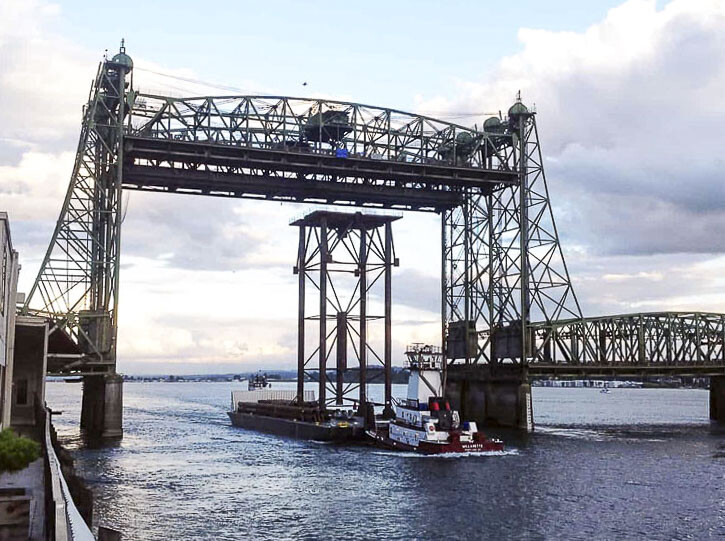
A movable span would accommodate the U.S. Coast Guard’s need that an I-5 Bridge replacement need a vertical navigation clearance of at least 178 feet
Ken Vance, editor
Clark County Today
The Interstate Bridge Replacement (IBR) program team recently added a movable span to its study of design options for an Interstate 5 Bridge replacement. However, IBR Administrator Greg Johnson believes external stakeholders want the project to move forward with a fixed span design.

After the IBR team initially proposed a 116-foot height for a new bridge design, U.S. Coast Guard officials revealed in June of last year (2022) that any replacement of the existing I-5 Bridge needs to have a vertical navigation clearance (VNC) of at least 178 feet. The existing I-5 Bridge has a lift span to accommodate the need for the taller vessels.
“In our commitment to partners to mitigate risks to our budget and timeline for construction, the Interstate Bridge Replacement (IBR) program in coordination with our federal partners, Federal Highways Administration (FHWA) and Federal Transit Administration (FTA), has included a movable span in our study of design options,’’ Johnson told Clark County Today in an email response this week.
“In February the Coast Guard delivered a letter to FHWA and FTA requesting that the program also study a design option that provides 178 feet of river clearance,’’ Johnson added. “To do this the program is moving forward with studying a movable span as part of the National Environmental Protection Act (NEPA) review process. Studying the movable span as a design option now serves as a risk mitigation strategy to minimize schedule delays and will allow the community and partners to provide public input through the official environmental review process in late 2023.’’
The Coast Guard’s statement of the need for a bridge height of 178 feet came at a time last summer when Johnson was visiting with area government agencies and partners seeking an endorsement for the IBR’s Locally Preferred Alternative (LPA), which included the proposed bridge height of 116 feet. He received what amounted to a “thumbs up’’ for the IBR team to continue with its proposed LPA.
This week, said he believes those same stakeholders support the proposed fixed span option, rather than the movable span he now says the IBR team will study.
“The program understands that external stakeholders want to move forward with a fixed span,’’ Johnson told Clark County Today. “We appreciate the responsibilities that the Coast Guard oversees and acknowledge the need to better understand the full range of benefits and impacts associated with a replacement bridge across the Columbia River. Additionally, the program will continue conversations with potentially impacted fabricators and businesses, who have expressed support for the replacement of the bridge and interest in mitigation agreement discussions necessary for a fixed span.’’
A little history
In a letter dated June 17, 2022, a Coast Guard official provided a summary conclusion for Preliminary Navigation Clearance Requirements of the proposed I-5 Bridge replacement.
“The Columbia River System is an extremely important interdependent-multimodal supporting national and international commerce critical to local, national and global economies,’’ wrote B.J. Harris, chief of the Waterways Management Branch, Coast Guard District Thirteen. “Reducing the capability and capacity of the Columbia River System would severely restrict navigation. IBR’s proposed bridge … with its 35% reduction of VNC from 178 feet to 116 feet is contradictory to the U.S. Coast Guard’s mandate from Congress to maintain freedom of navigation on the navigable waters of the U.S. and to prevent impairment to U.S. navigable waterways. “As new structures are built, navigation clearances should be improved or at a minimum maintained,’’ Harris continued. “Any proposed new bridge should have a VNC of greater than or equal to that of the existing I-5 twin bridges of 178 feet or preferable, unlimited VNC …’’
In his letter, Harris stated that alternative options are available and he even offered an example.
“There are alternative options to accomplish this VNC to include a tunnel or a high-level lift bridge or bascule bridge, which would provide an unlimited vertical clearance,’’ he wrote. “A modern similar successful project is the Woodrow Wilson Bridge over the Potomac River in Washington, DC that was completed in 2009. It is a higher-level double bascule lift bridge on an interstate (I-95) with transit. The added height of the new bridge reduced the number of bascule bridge openings for vessel passage by 76%.’’
At the June 17, 2022 Bi-state Bridge Committee meeting, the IBR team indicated that anything higher than 116 feet of clearance for the I-5 Bridge replacement would cause the IBR to have to go to a “moveable span.” Administrator Johnson had indicated that the moveable span could cost $400 million.
In his letter, Harris also stated that in addition to the 178-foot VNC that any side channels from the U.S. Army Corps of Engineers (ACOE) approved main navigation channel/project “would require vertical clearances equal to or greater than 72 feet.’’
“Generally, the Coast Guard does not approve bridge proposals with vertical navigation clearances below the ‘present governing structure’ when the existing VNC has been and is currently needed unless there is a compelling navigational reason to do so,’’ Harris wrote. “The existing I-5 twin bridges are the ‘governing structure’ on the Columbia River west of the Glenn Jackson I-205 Bridge. They are the lowest navigational obstruction (bridge or overhead cable) between the I-205 Bridge and west to the confluence of the Pacific Ocean and the Columbia River.
“Vessels with a VNCR of up to 178 feet have been able to navigate upriver from the Pacific Ocean since 1917, including past the first obstruction at the Astoria-Megler Bridge (with a vertical clearance of 193 feet),’’ he added. “The next four vertical clearance obstructions after the Astoria-Megler Bridge are between river miles 40 and 104 (with clearances ranging from 187 feet to 220 feet). A VNC of less than 178 feet would, for the first time in a century, decrease the present governing structure VNC by as much as 35% (reducing 178 feet to 116 feet). The next upriver VNC obstruction past the current governing structure is the Glenn Jackson I-205 Bridge approximately 6.75 miles upriver with a VNC of 136 feet to 144 feet.”
Harris wrote that “Multimodal Transportation Columbia River access facilitates the movement of products which are too large to truck or ship by rail. On-site barge access accommodates river and ocean-going vessels up to 400 feet in length, and with air drafts up to 178-feet tall. Outside storage capacity near the barge slips allows for unprecedented scale outdoor fabrication/assembly, staging and storage. CBC’s (Columbia Business Center) barge facilities are private and do-it-yourself in nature, eliminating red tape and outside controls and restrictions. CBC has accommodated construction of naval warships, yachts, oil rigs, bridge and dam components, and mass transit infrastructure. Dating back to its origins as a Kaiser shipyard and continuing to this day, the facilities at CBC allowed for prefabrication and special construction methods to efficiently produce products key to US national security and infrastructure. Whether the first occupant, Kaiser Shipyards; current tenants such as Greenberry Industrial, JT Marine, Thompson Metal Fab, or Vigor Industrial; or future tenants, it has always been the case that the vertical navigation clearance requirements of 178 feet under the Interstate 5 bridge have been critical to deliver products to and from markets.”
Costs
In November, the IBR produced a document with updated costs. In it, the IBR team reported the cost of the bridge itself is $500 million. Furthermore, the cost of a “lift span” is $930 million. A bascule bridge with unlimited clearance would cost $980 million.
Therefore, in order to meet the minimum requirement of the Coast Guard, it would cost $430 million. To improve clearance for a 100-plus year asset, it would cost an additional $480 million.
Many Clark County residents have resisted the IBR’s inclusion of MAX light rail in its LPA. The total cost of the project could be reduced by up to $2 billion by eliminating the MAX light rail, which also includes “new revenues” TriMet is demanding from residents on both sides of the Columbia River, to cover the operations and maintenance costs of a 3-mile light rail extension.
Also read:
- Opinion: Hiding the growing cost of the Interstate Bridge replacementJoe Cortright of the City Observatory addresses the rising cost of the Interstate 5 Bridge replacement project.
- 90 minutes of delay on Southbound I-5 in Southwest Washington on Friday afternoon, July 26Travelers using southbound Interstate 5 through Woodland should expect up to 90 minutes of delay during Friday afternoon and evening and should delay travel or prepare for additional travel time.
- Nighttime paving work on I-5 and SR 14 in Clark County July 28-Aug. 9Nighttime travelers in Clark County should expect delays for maintenance and paving work beginning Sunday, July 28 until the morning of Friday, Aug. 9.
- Northeast 182nd Avenue/Northeast Ward Road to be closed on Aug. 1Northeast 182nd Avenue and Northeast 172nd Avenue in Clark County will have single-day closures on August 1 and August 5 for road preservation, with detours in place.
- Interstate Bridge Replacement program awarded $1.499 billion FHWA Bridge Investment Program grantInterstate Bridge Replacement program officials have shared that the program received $1.499 billion through the Federal Highway Administration’s Bridge Investment Program.









